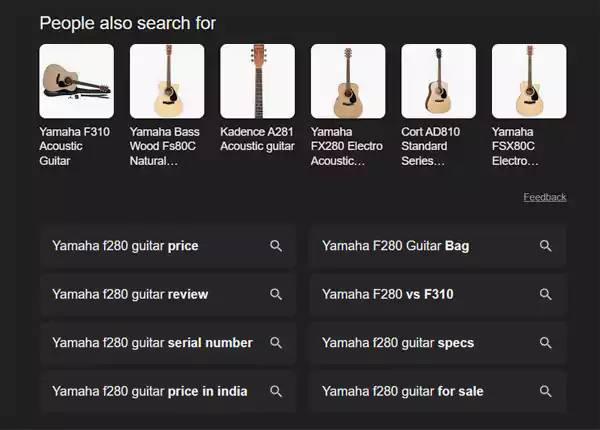People Also Search For (PASF): Uses, Significance, & How it’s Different from People Also Ask
With different kinds of strategies used to optimize your content, targeting “People also search for” is still one of the most underrated and impactful ones. It enables you to target the insights and variations of keywords along with the development and optimization of content.
So, why not use it? But before that, let’s understand what it is, how to find PASF keywords, and how it is different from “People also ask.”
- What is People Also Search For (PASF)?
- Where Does PASF Appear and Why Does It Matter?
- How PASF Influences SEO Strategy?
- How to Conduct Research for “People Also Search For” Keywords?
- How to Use People Also Search For Keywords in Your Content?
- PASF vs. People Also Ask: What’s the Difference?
- Bottom Line
- Frequently Asked Questions
What is People Also Search For (PASF)?
“People Also Search For,” or PASF, is nothing but a Google feature that shows the related search terms to users after they have clicked on a search result. These suggested terms are either contextually or behaviorally connected to the original query of the user.

For example, when we searched for the Yamaha F280 guitar, the People Also Searched For feature showed some related queries, as shown in the above image.
Let’s now find out where we can see PASF on SERP and why it is important.
Where Does PASF Appear and Why Does It Matter?
The “People Also Search For” feature is available on the bottom of the SERP, right above the pagination section where the option for the next page is located.
Now, let’s hop onto understanding why the “People Also Search For” feature is an important factor for SEO.
- Detects the Actual User Behavior: The “PASF” keywords are actually based on users’ search behavior, like what other queries people search related to the entered query.
- Scope for Long Tail Keywords: Keywords available in the people also searched for sections are mostly long tail keywords that can be used to narrow down your target audience.
- Covers a Wider Search Intent: These keywords not only strengthen your content’s relevance but also widen the scope of the search intent spectrum and create context around the primary keyword.
- Enables Better Internal Linking and Content Clustering: Targeting the people also ask for keywords can also allow you to create supporting blog posts, which can be interlinked together to build content clusters.
Also Read: Top 10 Link-building Tools for SEO to Track Organic Traffic in 2025
How PASF Influences SEO Strategy?
SEO professionals often utilize the “People Also Search For” to frame and optimize their content to strengthen their approach. Here are a few ways in which PASF influences SEO strategy.
1. Optimizes Content for Featured Snippets
Most of the “People Also Search For” terms are question-based and hence are perfect for targeting featured snippets and the People Also Ask box. This will help you gain extra volume even if you are ranked #1 on the SERP.
2. Recaptures Bounce Traffic
Usually, the People Also Searched For section comes to the SERP when the user bounces back to the Google results. So, targeting and optimizing your content for PASF terms can help you attract the audience that was not satisfied with the previous results.
3. Increases Organic Visibility
Targeting the PASF terms can allow you to rank on multiple variations of keywords, which can increase your chances of appearing on SERP while also dominating the competitors.
4. Enhances Engagement Signals
Your content keeps readers interested by addressing the natural flow of user questions. Google looks at longer session times, lower bounce rates, and better user engagement metrics, all of which are signs that your site is valuable.
How to Conduct Research for “People Also Search For” Keywords?
With this much command and knowledge over the “People Also Search For” keywords, let’s delve deep into this and understand how to find these keywords and what the right way to use them is.
1. Begin With a Focus Keyword
Search for a broad or primary keyword of a related industry. Make sure that your primary keyword is relevant to your business, product, or content. In this way, your search can easily be featured with the people also searching for a box.
2. Find the PASF Section and Analyze the Keywords
Scroll down on the SERP after searching your query, and you will see a PASF section, containing different long terms. You can effortlessly use these terms to understand the search intent and target the right audience.
3. Use Keyword Research Tools
Once you have analyzed and selected the PASF keywords for targeting, it’s time to utilize keyword research tools, like Semrush, Ahrefs, Google Keyword Planner, Ubersuggest, etc., to gain additional data, such as search volume, competition level, and related keywords.
4. Analyze Competitors
Once you have grouped all the targeting PASF keywords, search them on SERP and analyze the top-ranking competitors. Conduct research on why these pages are ranking so high. It will help you deeply understand the intent of the queries and strategize the correct approach.
5. Use Analytics Tools
After opting for all the steps mentioned above, it’s time to use any analytics tool, like Google Analytics 4, to track the performance of the keywords on some specific metrics, like traffic, conversions, bounce rate, etc.
Also Read: 15 Cutting-Edge SEO Content Writing Tips for 2025: Rank Higher with Smarter Strategies
How to Use People Also Search For Keywords in Your Content?
Let’s see how to use the people also search for section for keywords in your content. By knowing proper usage, you can rank in Google people also search for box:
- Headings: To boost topical relevance, improve content structure, and raise your chances of ranking for related search queries, use PASF keywords in your subheadings (H2/H3).
- Frequently Asked Questions: To target “People Also Ask” results and increase your chances of showing up in featured snippets, use PASF keywords as FAQs.
- Body Content: Incorporate PASF keywords naturally into the body of the text to improve semantic relevance and aid search engines in comprehending the context of your material.
- Anchor Text for Interlinking: To create powerful topic clusters, enhance site navigation, and increase SEO authority, use PASF keywords as anchor text for internal links.
- Image Alt and Meta Description: To increase search visibility and strengthen content relevance across SERP features, incorporate PASF keywords into image alt text and meta descriptions.
People Also Search For vs. People Also Ask: What’s the Difference?
With a lot of confusion among the experts on the “People Also Search For” and “People Also Ask” sections, we have decided to offer you a detailed distinction between the two to help you utilize them more effectively.
| Attributes | People Also Search For | People Also Ask |
| Definition | It is a feature that presents the related search terms or alternative search queries based on the original user search intent. | It is a feature that displays a bunch of related questions to the user’s search intent query. |
| Location on SERP | PASFs are usually located at the bottom of the SERP. | PAAs are usually located in the middle of the page, nearly at the top of the SERP. |
| Interactivity Score | Static (redirects to a new search engine results). | Highly interactive (people click on the question and get the answer). |
| Content Type | The content type is optimized with the long-term keyword or phrases related to the search query. | PAA consists of the questions and common answers related to the original search intent. |
| Content Source | Google’s algorithm understands the related queries/questions. | Google’s database of frequently asked or searched users’ questions. |
| Ranking Opportunity | Low direct value. | High direct value (you can rank by answering the frequently searched questions). |
Also Read: 25 Improvement of Web Page Visibility by Maximizing SEO Efforts
Bottom Line
The “People Also Search For” section on the SERP can be your go-to option for targeting the right audience and gaining traffic on your website. Most people are unaware of the fact of how useful the PASF section can be. This box feature of Google displays similar queries of users based on the searches and algorithm.
By utilizing the PASF in your SEO processing, you can develop more user-focused and efficient content strategies.
Frequently Asked Questions
Ans: The PASf is located at the bottom of the SERP in a small box with various long-tail keywords.
Ans: Although they are both related search features, PAA offers related questions right in the search results, whereas PASF concentrates on making related search phrase recommendations based on user behavior after the user has already searched.
Ans: Although the number might slightly vary depending on the query and device, generally, there are 6-8 PASF keywords featured on the SERP.










